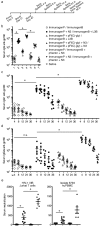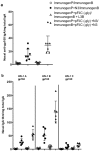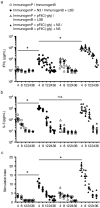DNA-Encoded Flagellin Activates Toll-Like Receptor 5 (TLR5), Nod-like Receptor Family CARD Domain-Containing Protein 4 (NRLC4), and Acts as an Epidermal, Systemic, and Mucosal-Adjuvant
- PMID: 26344341
- PMCID: PMC4494208
- DOI: 10.3390/vaccines1040415
DNA-Encoded Flagellin Activates Toll-Like Receptor 5 (TLR5), Nod-like Receptor Family CARD Domain-Containing Protein 4 (NRLC4), and Acts as an Epidermal, Systemic, and Mucosal-Adjuvant
Abstract
Eliciting effective immune responses using non-living/replicating DNA vaccines is a significant challenge. We have previously shown that ballistic dermal plasmid DNA-encoded flagellin (FliC) promotes humoral as well as cellular immunity to co-delivered antigens. Here, we observe that a plasmid encoding secreted FliC (pFliC(-gly)) produces flagellin capable of activating two innate immune receptors known to detect flagellin; Toll-like Receptor 5 (TLR5) and Nod-like Receptor family CARD domain-containing protein 4 (NRLC4). To test the ability of pFliC(-gly) to act as an adjuvant we immunized mice with plasmid encoding secreted FliC (pFliC(-gly)) and plasmid encoding a model antigen (ovalbumin) by three different immunization routes representative of dermal, systemic, and mucosal tissues. By all three routes we observed increases in antigen-specific antibodies in serum as well as MHC Class I-dependent cellular immune responses when pFliC(-gly) adjuvant was added. Additionally, we were able to induce mucosal antibody responses and Class II-dependent cellular immune responses after mucosal vaccination with pFliC(-gly). Humoral immune responses elicited by heterologus prime-boost immunization with a plasmid encoding HIV-1 from gp160 followed by protein boosting could be enhanced by use of pFliC(-gly). We also observed enhancement of cross-clade reactive IgA as well as a broadening of B cell epitope reactivity. These observations indicate that plasmid-encoded secreted flagellin can activate multiple innate immune responses and function as an adjuvant to non-living/replicating DNA immunizations. Moreover, the capacity to elicit mucosal immune responses, in addition to dermal and systemic properties, demonstrates the potential of flagellin to be used with vaccines designed to be delivered by various routes.
Keywords: DNA adjuvant; NLRC4; TLR5; adaptive immunity; flagellin.
Figures










Similar articles
-
Long-Lasting Mucosal and Systemic Immunity against Influenza A Virus Is Significantly Prolonged and Protective by Nasal Whole Influenza Immunization with Mucosal Adjuvant N3 and DNA-Plasmid Expressing Flagellin in Aging In- and Outbred Mice.Vaccines (Basel). 2019 Jul 16;7(3):64. doi: 10.3390/vaccines7030064. Vaccines (Basel). 2019. PMID: 31315253 Free PMC article.
-
Clostridium difficile flagellin FliC: Evaluation as adjuvant and use in a mucosal vaccine against Clostridium difficile.PLoS One. 2017 Nov 27;12(11):e0187212. doi: 10.1371/journal.pone.0187212. eCollection 2017. PLoS One. 2017. PMID: 29176760 Free PMC article.
-
Toll-like receptor 5 is not essential for the promotion of secretory immunoglobulin A antibody responses to flagellated bacteria.Microbiol Immunol. 2015 Dec;59(12):716-23. doi: 10.1111/1348-0421.12336. Microbiol Immunol. 2015. PMID: 26564803
-
Norovirus (NoV) specific protective immune responses induced by recombinant P dimer vaccine are enhanced by the mucosal adjuvant FlaB.J Transl Med. 2016 May 17;14(1):135. doi: 10.1186/s12967-016-0899-4. J Transl Med. 2016. PMID: 27184355 Free PMC article.
-
Structural engineering of flagellin as vaccine adjuvant: quest for the minimal domain of flagellin for TLR5 activation.Mol Biol Rep. 2025 Jan 7;52(1):104. doi: 10.1007/s11033-024-10146-y. Mol Biol Rep. 2025. PMID: 39775323 Free PMC article. Review.
Cited by
-
Bacterial flagellin-a potent immunomodulatory agent.Exp Mol Med. 2017 Sep 1;49(9):e373. doi: 10.1038/emm.2017.172. Exp Mol Med. 2017. PMID: 28860663 Free PMC article. Review.
-
Immunization with recombinant HPV16-E7d in fusion with Flagellin as a cancer vaccine: Effect of antigen-adjuvant orientation on the immune response pattern.Immunol Res. 2025 Feb 13;73(1):50. doi: 10.1007/s12026-025-09598-6. Immunol Res. 2025. PMID: 39939497
-
Translating known drivers of COVID-19 disease severity to design better SARS-CoV-2 vaccines.Curr Opin Virol. 2022 Feb;52:89-101. doi: 10.1016/j.coviro.2021.11.012. Epub 2021 Dec 11. Curr Opin Virol. 2022. PMID: 34902803 Free PMC article. Review.
-
Genetic adjuvants: A paradigm shift in vaccine development and immune modulation.Mol Ther Nucleic Acids. 2025 Apr 8;36(2):102536. doi: 10.1016/j.omtn.2025.102536. eCollection 2025 Jun 10. Mol Ther Nucleic Acids. 2025. PMID: 40336572 Free PMC article. Review.
-
Inflammasome-Mediated Immunogenicity of Clinical and Experimental Vaccine Adjuvants.Vaccines (Basel). 2020 Sep 22;8(3):554. doi: 10.3390/vaccines8030554. Vaccines (Basel). 2020. PMID: 32971761 Free PMC article. Review.
References
-
- Jones S., Evans K., McElwaine-Johnn H., Sharpe M., Oxford J., Lambkin-Williams R., Mant T., Nolan A., Zambon M., Ellis J., et al. DNA vaccination protects against an influenza challenge in a double-blind randomised placebo-controlled phase 1b clinical trial. Vaccine. 2009;27:2506–2512. doi: 10.1016/j.vaccine.2009.02.061. - DOI - PubMed
-
- Applequist S.E., Rollman E., Wareing M.D., Liden M., Rozell B., Hinkula J., Ljunggren H.G. Activation of innate immunity, inflammation, and potentiation of DNA vaccination through mammalian expression of the TLR5 agonist flagellin. J. Immunol. 2005;175:3882–3891. - PubMed
LinkOut - more resources
Full Text Sources
Other Literature Sources
Research Materials
Miscellaneous

